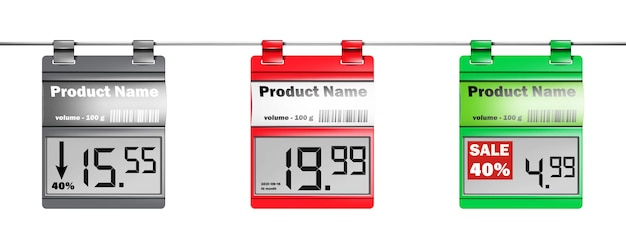The 15% Rule: Is That Discount Really Worth It?

The 15% rule serves as a practical guideline to assess whether a discount justifies a purchase, helping consumers avoid impulsive decisions and ensuring that savings align with their financial goals and needs.
Navigating the world of discounts and promotions can be tricky. How do you know if a deal is genuinely worth your money? The 15% rule: How to determine if a discount is actually worth your money, offers a simple yet effective framework for making smart purchasing decisions.
Understanding the 15% Rule
The 15% rule is a guideline that suggests you should only buy something on sale if the discount is at least 15% of the original price. This helps you avoid buying things you don’t need just because they’re on sale.
The Core Principle
At its core, the 15% rule is about mindful spending rather than reckless bargain hunting. It encourages consumers to pause and evaluate whether a discounted item truly offers significant savings.
Why 15%?
The 15% threshold isn’t arbitrary. It represents a balance between a meaningful discount and the potential for impulse buying. Here’s why it works:
- Prevents Impulse Buys: A small discount might tempt you to buy something you don’t need.
- Meaningful Savings: 15% off is a tangible saving that can add up over time.
- Encourages Evaluation: The rule prompts you to assess if the item fits your needs and budget.
The 15% rule is a simple yet powerful tool that promotes smarter spending habits. By setting a minimum discount threshold, you’re more likely to make purchases that align with your financial goals and needs.

How to Apply the 15% Rule
Applying the 15% rule is straightforward. It involves a quick calculation and a bit of self-reflection to determine if a discounted item is a worthwhile purchase.
Step-by-Step Guide
Here’s how to effectively use the 15% rule when shopping:
- Identify the Original Price: Note the item’s original price before any discounts.
- Calculate the Discount Amount: Multiply the original price by 0.15 to find the minimum acceptable discount.
- Compare the Discount: Check if the actual discount meets or exceeds the calculated amount.
- Assess Your Need: Ask yourself if you truly need the item, regardless of the discount.
Real-World Examples
Let’s look at a couple of scenarios to illustrate how the 15% rule works in practice:
- Scenario 1: A jacket originally priced at $80 is on sale for 20% off. The discount is $16, exceeding the 15% threshold of $12.
- Scenario 2: A gadget priced at $50 is marked down by 10%. The discount is $5, falling short of the 15% threshold of $7.50.
- Scenario 3: A kitchen appliance priced at $200 has a discount of 30%. The discount is $60 and exceeds the 15% threshold of $30.
By following these steps and examples, you can confidently apply the 15% rule to your shopping decisions. It’s a practical way to ensure you’re making informed choices and maximizing your savings.
Benefits of Following the 15% Rule
Adhering to the 15% rule offers numerous benefits beyond just saving money. It promotes financial discipline, reduces clutter, and encourages mindful consumption.
Avoid Impulse Purchases
One of the most significant advantages is the reduced likelihood of impulse buys. By setting a minimum discount, you avoid the temptation of buying things you don’t need simply because they’re on sale.
Save Money
The rule helps you save money by ensuring that your purchases offer substantial value. Small discounts can be enticing but often lead to unnecessary spending.
Reduce Clutter
Mindful shopping reduces clutter in your home and life. By only buying items that meet the 15% discount threshold and fulfill a genuine need, you avoid accumulating excess stuff.
Promote Conscious Consumption
Following the 15% rule encourages thoughtful consumption. You’re more likely to evaluate your needs and priorities before spending, leading to a more sustainable and intentional lifestyle.
By embracing the 15% rule, you’re taking a step towards financial well-being and mindful living. It’s a simple yet effective way to gain control over your spending habits.
Common Pitfalls to Avoid
While the 15% rule is a useful tool, it’s essential to be aware of common pitfalls that can undermine its effectiveness. Understanding these challenges can help you make even smarter shopping decisions.
Marketing Tactics
Be wary of marketing tactics designed to mislead you. Some retailers inflate original prices before applying discounts to make the deal seem better than it is.
Limited-Time Offers
Avoid succumbing to the pressure of limited-time offers. These promotions often create a sense of urgency that can lead to impulsive buying.
Ignoring Your Budget
Even with a 15% discount, it’s crucial to stay within your budget. Don’t let a good deal tempt you to overspend or neglect your financial priorities.
Quality Concerns
Discounts can sometimes indicate lower quality or outdated products. Always assess the item’s quality and condition before making a purchase, regardless of the discount.
By staying informed and vigilant, you can navigate the world of discounts with confidence. The 15% rule is a valuable tool, but it’s just one component of responsible financial management.

Alternatives to the 15% Rule
While the 15% rule provides a solid foundation for smart spending, there are alternative approaches you can consider to tailor your shopping strategies to your unique needs and preferences.
The 50/30/20 Rule
The 50/30/20 rule allocates 50% of your income to needs, 30% to wants, and 20% to savings and debt repayment. This approach helps you prioritize essential expenses and allocate a set amount for discretionary spending, including discounted items.
The 24-Hour Rule
The 24-hour rule involves waiting 24 hours before making a non-essential purchase. This pause allows you to evaluate whether you genuinely need the item and prevents impulse buying.
The One-In, One-Out Rule
The one-in, one-out rule encourages you to declutter your home before buying something new. For every item you bring in, you must remove one similar item. This helps prevent clutter and promotes mindful consumption.
Personalized Discount Threshold
Consider setting a personalized discount threshold based on your financial goals and values. You might decide that only discounts of 20% or higher are worth your attention, depending on your individual circumstances.
The 15% rule is a versatile guideline, but it’s essential to explore different strategies and find what works best for you. Combining various approaches can lead to even smarter financial decisions.
Adapting the 15% Rule to Different Purchases
The 15% rule can be adapted to different types of purchases, from everyday items to big-ticket investments. Tailoring the rule to specific situations can enhance its effectiveness.
Everyday Essentials
For everyday essentials like groceries or household supplies, the 15% rule can help you save on items you regularly need. Stock up on discounted items that you know you’ll use.
Clothing and Accessories
When shopping for clothes and accessories, the 15% rule can prevent impulse purchases. Only buy items that you genuinely love and that fit your style and wardrobe.
Electronics and Appliances
For electronics and appliances, a higher discount threshold might be appropriate. Consider waiting for discounts of 20% or more, especially for big-ticket items.
Experiences and Services
The 15% rule can also apply to experiences and services like travel or entertainment. Look for discounts on activities that align with your interests and budget.
By adapting the 15% rule to different categories, you can make informed decisions across all areas of your spending. It’s a flexible tool that promotes financial well-being in various contexts.
| Key Point | Brief Description |
|---|---|
| 💰 Minimum Discount | Ensure discounts are at least 15% to justify purchases. |
| ✅ Need vs. Want | Assess if the item is a necessity before buying it on sale. |
| 📊 Budget Awareness | Stay within your budget, even with attractive discounts. |
| 🛡️ Avoid Impulse Buys | Use the rule to prevent unplanned and unnecessary purchases. |
Frequently Asked Questions
▼
The 15% rule is a guideline suggesting that you should only consider buying an item if it’s discounted by at least 15% of its original price. This helps you avoid making impulsive purchases.
▼
To calculate, multiply the original price by 0.15. If the discount amount is equal to or greater than this result, the discount meets the 15% rule.
▼
It promotes mindful spending, helps prevent impulse purchases, ensures you’re getting substantial savings, reduces clutter, and encourages conscious consumption.
▼
Yes, for big-ticket items or luxury goods, you might want to wait for even higher discounts. Also, consider your budget and needs before making any purchase.
▼
Absolutely! The 15% rule is a guideline, not a rigid law. You can adjust the percentage based on your financial situation and spending habits to make it more effective for you.
Conclusion
In conclusion, the 15% rule: How to determine if a discount is actually worth your money, is a practical tool for making informed purchasing decisions. By setting a minimum discount threshold and considering your needs and budget, you can avoid impulse buys, save money, and promote mindful spending.





